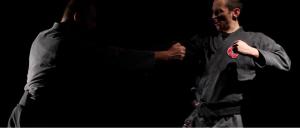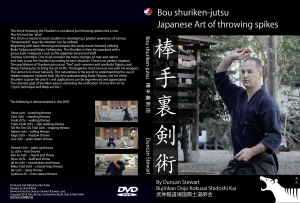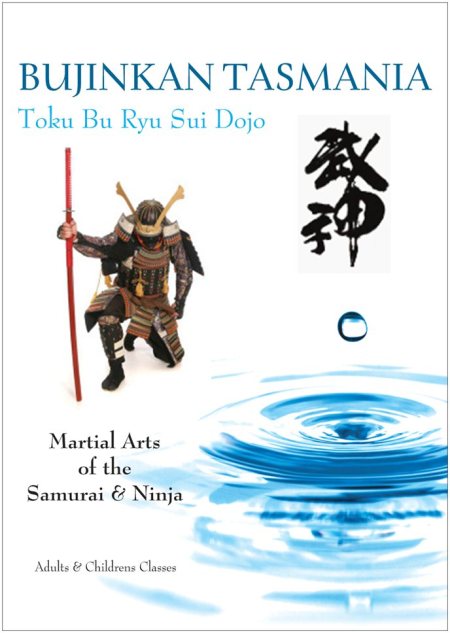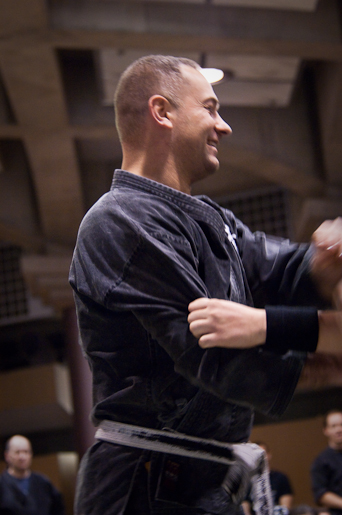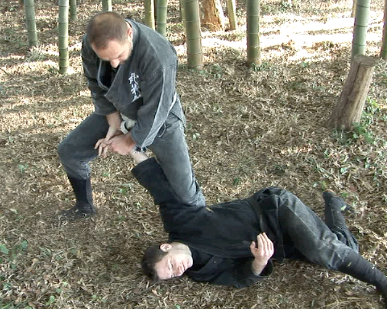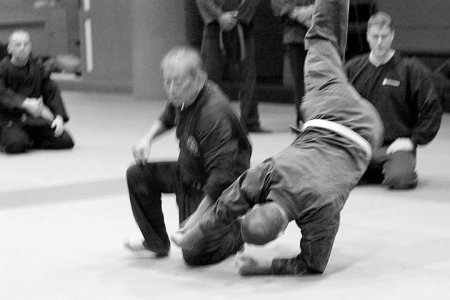BUJINKAN TASMANIA ( Toku Bu Ryu Sui Dojo ) WEBSITE
Posted in Uncategorized on October 10, 2013 by Duncan StewartShin Gi Tai Bufu Ikkan Shou
Posted in Uncategorized on September 19, 2013 by Duncan StewartSHIKIN HARAMITSU DAI KOMYOU
Posted in Uncategorized on February 24, 2013 by Duncan StewartThe Bujinkan Dojo is a new entity, yet holds within it the cultural treasures and traditions since the dawn of Amaterasu. Soke has said that he is worried that the Japanese culture is moving in a direction where “traditions” are being forgotten. The role of the Bujinkan Dojo is to preserve the essence of the traditions through the martial arts while adapting to survive with the evolution of man and world he lives in.
If people care not about the traditional aspects of budo, we are in a sence ” killing ” the art or saying that tradition is not important any more. The Bujinkan is a holistic art form. We must learn from the past to assist with the development of the future. Nagato Sensei during his classes often states that there are no shortcuts and that the larger more traditional forms must be practised and studied well, especially in regards to long weapons etc.
In the Bujinkan, we do this from kata. Kata helps us appreciate the history, traditions and culture of the martial arts of Japan. We also come to experience how culture and people have evolved in both mind, body and spirit. This is, in a way, a practical or ” hands on ” sociological or anthropological study of not only the Japanese culture but the cultures of the world. In a very natural sence through the study of budo, the practitioners of the martial arts become Anthropologists and Philosophers.
Budo requires individuals to come together ( often as groups ) and physically enter movements of combatative study. For many, this is an extremely challenging step. The dojo holds within it a great chance for each individual to truly develop a working knowledge of their humanity,mortality, and place in the world. The dojo is a sanctioned area by Kami ( god ) to learn through hardship the purpose and correct manner in which to connect with others to minimise violence. It is quite a dichotomy really. However, it is the only way to truly learn to value human life.
The fighting arts within the Bujinkan all commence with “spiritual purification”. This is extremely important. The practitioner must develop with a balance. If the person does not evolve with a balanced mind, then they will never naturally know when to act and not to act. Violence is to be avoided at all costs, yet the martial artist without the mind for peace, may rush into violence. Often it is said that all a good man has to do to defeat evil is to do nothing. Many people will see this comment as pacifist in nature. But to me, it is not. I have watched and listened to Soke, and I believe he follows the path of natural justice. I have thought about his manner of dealing with various issues and seen the results of this path way lead by Soke. I now try to build a greater capacity to trust in it as well.
It is in fact strategy of the highest nature and maturity. It is allowing the Universe to uphold natural justice. To relinquish ones own desires and allow the power of nature to take it`s course is knowing the “mind and eyes of god”. Those that need to be in control and have to take charge, are in their own ego. The release of the ego is to understand Mushin. To move from a state of nothingness or zero, is to move as dictated by nature and not your own selfish desires. The martial arts is about relinquishing oneself to a higher power. It is often a very difficult thing to do because we cannot see this power. As a result, we cannot trust in it and hold onto what we know and believe with our own consciousness. A step to trusting this power is the godan test. This test for both the giver and reciever is a move toward acknowledging and trusting in a greater power than ones own. In regards to the godan test, it is often discussed that the giver must emit a killer intention. This killer intention ( as described once to me ) is actually an act of compassion. It is also a test of the givers unification of shin gi tai. The ultimate goal of the martial artist is to win without entering the fight. The emission of sakki and making the reciever move is one way of testing this. We must consider why sakki is emitted? Any professional would try to hide this “killer intention”, as he does not want his adversary to move or have the chance to defend himself. So, the emission of Sakki is for a variety of reasons.
These things come to mind through the experience of training. The mind cannot understand alone. You have to learn through the body ( practise ). This is patience. If you do not have patience to learn this way, there will be the desire to ask questions ( with the mind ). People ask questions and want to know the answers to things that are too advanced for their actual ability and understanding. They may recieve the answers but, they still do not know the real truth because of their lack of training. It is the same with the Densho. It matters not who sees the densho, even if they are translated in all languages and can speak fluently in Japanese. The fact is, very few people have had the depth of training and life experience to understand the teachings of the waza.
I am one of these people. I`m a person who in actuality, understands barely the tip of the iceberg when it comes to the martial arts and the art of living. I am a lowly student trying to live the way of budo. I study the Bujinkan within my capacity. This is all I can do.
I was once approached by a person at a seminar after I mentioned a “secret teaching” ( unknowingly by this person from one of Sokes books ). They said ” Why are you giving away secrets?” I said ” Do you understand what I said?” They said, “No.” I said, ” Well, it`s still a secret then!”
南虎
PHOTO BY SHEILA HADDAD
Bujinkan Tasmania
Posted in Uncategorized on February 14, 2013 by Duncan Stewart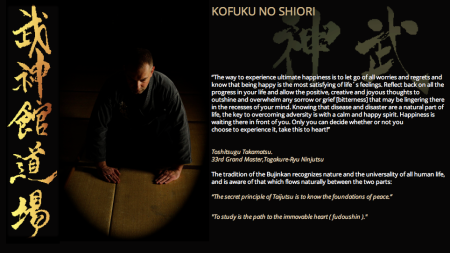
The Bujinkan Tasmania Dojo will commence training from October 2013.
This is a page from the proposed Bujinkan Tasmania Dojo website. The site will be on-line later in the year.
Classes for Adults and Children will be available.
I look forward to returning back home to Tasmania and training in Budo with friends.
Yoroshiku Onegaishimasu.
Duncan
DVD Website is now open!
Posted in Uncategorized on November 21, 2012 by Duncan StewartBou Shuriken-jutsu DVD
Posted in Uncategorized on November 16, 2012 by Duncan Stewart
A simple DVD has been produced for Bujinkan students and those interested in Shuriken-jutsu.
The DVD will be available for order by the 1st December 2012.
The express aim of this dvd is to add life to the training by ensuring students use taijutsu and taihenjutsu. Weapons can fail and not be effective. Relying on the Shuriken alone is not enough. The student must understand that the opponent will be moving and also may be throwing shuriken in return!
Understanding these realities, the student is encouraged to study with the knowing that Budo Taijutsu and Taihenjutsu are the means to survival. Not just the Shuriken. A weapons specialist without his weapon or any other skill is a weakness.Soke Hatsumi exclaims that Taijutsu is the base for all weapons and survival.
The Dvd gives humble examples of basic throwing practice, basic variations utilizing various methods of taihenjutsu and weaponry, and then demonstrations of shinken gata ( possible real life scenario methods ).
The demonstrator in the DVD is not a master of shuriken-jutsu and is still correcting on a daily basis his faults and weaknesses. This Dvd is a means to merely encourage others on using imagination and think about the infinite variations one may encounter and how to effectively use the shuriken in those moments.
Duncan is a long time practitioner of Bujinkan Budo. He knows and trusts that the art of shuriken-jutsu exists in the Bujinkan. Upon learning the fundamentals of throwing, the student of Bujinkan Shuriken-jutsu must take the time to study and practice, constantly refining their technique. But most importantly, never forgetting to use Budo taijutsu: The core or “Kaname” of Bujinkan Budo.
The Bujinkan technique is “Ninja technique”. One must throw “naturally” in ones own way, free from form or style. This allows the practitioner to be open to change, be unpredictable, and adjust accordingly using Bujinkan Budo Taijutsu Happou Biken and Ninpo Taihenjutsu.
I sincerely hope that those who view this DVD will look at training as something more than throwing at a mat.
DVD Order Details:
- Currently the DVD will be only available at Bushinden Kai and at the Toku Bu Ryu Sui Bujinkan Dojo in Kashiwa, Japan.
- It is expected that there will be a designated distributer in Japan,Europe, The United States and Australasia in the near future.
- Direct Downloads may be available in the future if there is a big enough demand.
- International Order Price 4000yen ( approx: $47AUD, $49USD, 38Euro ) – Price includes Postage & Handling.
- Bushinden Kai and Toku Bu Ryu Sui Dojo sale price is 3000yen.
- Orders can be made through http://www.Paypal.com. Account name: http://www.bujinkantasmaniadojo@yahoo.com.
Bujinkan Tasmania Dojo
Posted in Uncategorized on November 1, 2012 by Duncan StewartThe establishment of the Tasmania`s first full-time Bujinkan Dojo is in place.
Donations are welcome to assist with the planning and development of Tasmania`s first full-time facility directed at transmitting Bujinkan Budo and other Japanese Cultural Arts by qualified instructors.
It is the express aim to develop the Japanese cultural arts that comprise the Bujinkan in Tasmania, offering a wonderful opportunity for interested people and groups to affiliate themselves with such a rich history and martial way expressing true art and humanity.
Donations can be sent via to the Dojo Paypal Account at http://www.paypal.com.
http://www.bujinkantasmaniadojo@yahoo.com
Bufu Ikkan.
Toku Bu Ryu Sui Dojo Youtube Channel
Posted in Uncategorized on September 27, 2012 by Duncan Stewart生
Posted in Uncategorized on September 21, 2012 by Duncan StewartDon`t seek to improve. Seek to learn how to endure and maintain the spirit of Heijoushin and Fudoushin.
There is no limit to Budo. There are limits to sports. People must retire or become a coach after a certain period in the sporting world.
Budo is not a sport. We train and study for life, not to win. To win is the concept of a fighter. The feeling of the Budoka is that of surviving. Winning and losing, strength and weakness have no meaning in the real world. Survival requires the living entity to understand that “change” and “adaptability” is the key point ( kaname ).
Therefore, the kaname is forever changing and evolving. This has been the essence of the nine schools that comprise the Bujinkan for thousands of years. Soke trusts this and thus, does nothing to change it. This is wisdom. People attempt to change things because it does not fit with their concept of what martial arts is. They therefore are not really listening to thousands of years of blood,sweat and tears. Do people really think they know better than 2000 years of knowledge after only 25 years of training in the modern world? Soke doesn`t. He has been training for over 50 years and still listens and follows his teachers words and teachings.
This is why I look at the evolution of the Bujinkan through the concept of Shu Ha Ri. We are seeing the evolution of a man ( soke ) and his training path from beginning to end. The most important thing is to search for the Kaname of this process. Takamatsu Sensei apparently said that the most important thing is “sincerity” or magakoro.
Keep training and polish your heart under the sword that cuts away ones vices so you may clearly see the way of living as a martial artist in tune with nature.
忍
This is the path I try to walk.
Thoughts on Rank
Posted in Uncategorized on June 13, 2012 by Duncan StewartThe ranks in the Bujinkan are for heart.
Those with the right heart will accept rank from their teacher without question.
The student, with their feeling of discomfort or inadequcey for their new rank, should then go away and train hard until they become worthy of the grade.
This is understanding Sakizuke.
This is the correct feeling to have when dealing with the Bujinkan grades.
Everyone in the Bujinkan receives rank based on Sakizuke ( attaining a rank before the actual skill/understanding is achieved ).
It is important to understand this and therefore not become concerned with ranking requirements to achieve a higher rank.
The Bujinkan is like an Organism, rather than an Organisation. It is alive and very natural.
Those that wish to control their dojo by creating set requirements, rules and obligations etc, often are going against natures way.
All we have to do is trust in Sokes manner of transmitting his budo and train hard to obtain Shin Gi Tai Ichi.
There are over 300 jugodan ranks in the Bujinkan world today. Soke has said that none of them are masters. His ranks are in “hope” that one day, some masters will sprout from this group. this is an important teaching. It is important for everyone to keep training and never become complacent or satisfied with their supposed rank. Rank is transparent in the real world. The teachings are to remove oneself from the constraints of material gain and reward and to understand that the “shugyo” is the most important thing. The training never ends and the master never thinks of being a master. The master thinks of himself as forever a student. This is what truly inspires. Very few people in any martial art can truly become masters. Thus, the ranks of the Bujinkan are alive and people succeed or fail just as in life. The ranks of the Bujinkan are teaching that life and budo are one in the same. Therefore, we are encouraged to walk everyday with an everyday mind and just think of “keeping on Going”. That is all that matters – Bufu ikkan!!

Words based on recent thoughts sprouting from classes in Japan.
Think by Yourself.
Posted in Uncategorized on June 13, 2012 by Duncan StewartTHINK BY YOURSELF
– By Soke Masaaki Hatsumi
In ancient times, a person who strve to learn budo would do individual keiko. After learning skills from his teacher, he trained himself to master those lessons. He had to have the determination to study through the techniques alone. Going into the mountains, he would repeat his solo training in nature, fighting with animals and trees.
These days, so many people forget to ” go into the mountains.” These people tend to desire the easy way out. If they are having problems that are complicated, they immediately ask someone older to solve it for them. Moreover, the elder gives them easy advice. Most people answer nicely because they think it would be good to help the situation along, but in fact, this often ends up hurting the individual`s growth.
It might be a little different from keiko in budo, but some problems can only be understood by the person who has the problem. An advisor gives suggestions trying to solve the problem through applying his own experiences, while the listner ( who does not have those same experiences ) listens to the guidance as if it were being recieved from some divine being. There is sometimes a serious danger in issing a lesson`s important point. Therefore, you should sometimes offer the advice, ” Ponder the dilemma yourself,”You may consider this ” coldhearted.” However, being cold illustrates the need to solve a problem ( finding warmth ).Perhaps some days later, the individual will return saying: ” I can`t figure out a solution…” and he will recount his problem in a totally different manner than his first telling. You will now be able to discern how to offer advice that is more appropriate by judging from his revised account.
In budo, we inform students of the proper answer after the “torment”, of making them think for themselves. Some things must be learned through suffering or they will be forgotten for the rest of your life. We must all learn to solve our own difficult problems.Furthermore, in budo, we suffer great pains to master the best techniques. It was throught the pains and labors of our ancestors, who became the founders of our traditions, that these techniques were invented.
Move. Stop. Think.
Posted in Uncategorized on June 13, 2012 by Duncan StewartThe more I train, I find I know very little.
When I do train though, I am searching out for the kotsu or “knack” of what is being transmitted.
To do this requires a particular focus and understanding of the feeling behind the training in the Dojo.
In order to practise, the uke and tori must assist in each others learning.
The beginning stages of the physical training can be related to SHU level. This is the stage of taking the time to learn set movements with set attacks. In this stage, there is no Henka or “variations”. The Tori is learning a new skill set and pursuing the training as an “in depth study of the self and uke”.
Nagato Shihan has said once, ” Move,Stop,Think.” The training is about moving with logic to learn the mechanics of the body, basic physics and the workings of the principals of timing,distance and angles.
You learn about leverage and how to achieve it with correct body movement.
We Move to an attack from uke and then Stop. At this point you can Think/observe your balance and that of your uke. You can see if you are in distance for another attack, does he/she have a hidden weapon, what is around you, does your angle of position put you in advantage or disadvantage, etc etc.
Training is about discovering your weak points and learning how to make them into strengths or how to make them work for you ( kyojutsu ). To do this, we must take the time and practise slowly so the mind,body and the technique can unify. This is Shin Gi Tai Ichi – the ultimate goal of the martial artist.
We are studying to live with balance. The process of learning Budou is helping us to ahcieve this. Just as there is a process to life, there is a process to learning.
Basically, people are trying to run before they can walk. People want to make the training “more realistic” by increasing attacks with speed, power and resistance. They do ths too quickly. They have not taken heed of the first code of the Dojo – Know that patience comes first.
The fact is, most of the training we recieve ( in a Shihans class ) is at a level where we are to “mimic” and learn their taijutsu. We do this to rid ourselves of our bad habits and learn to move correctly like our masters. We are all beginners in their class. If you are not, then you cannot learn. It is very important to generate the right mind set. This level of training is the first level. If you cannot get what is shown to you in the basic form, then how can you move forward and train in henka? You first have to have something ( SHU ) before you can break ( HA ) it.
The teacher asks his Uke to peform a set attack. The attack for this example shall be a right punch.
The Uke lunges at him with deep but centered attack with body. The teacher moves, captures the energy and redirects the energy to control the uke. He then asks everyone to “do just that”.
What is important during this stage, is that the students watching observe both the uke and tori during the demonstration. If the students want to try and gain a “feeling” of what was shown, they must “mimic” both roles the best they can.
Nagato Shihan has recently had to resort to lining people up in the dojo and counting out the sequence of movements while getting everyone to mimic him. It comes down to ” having a childs mind”. If the mind is cluttered and full of things ” we want to see” rather than empty and absoring directly the things ” that really are ” then we will always have difficulty learning.
In Dojo around the world, I see people who are Dan ranks that cannot even perform the basic te-sabaki ( hand movements ) for the Koshi Kihon Sanpo. As to help these people and also to help their students, I break the fundamental kata down into three physical skill sets.
Te-sabaki
Tai-sabaki
Ashi-sabaki
When I do this, people can see their shortcomings in each waza. Then, after they can “see” ,they have the opportunity to practise and learn correctly. After these skill sets are mastered, then they are unified to complete the kata as we normally see them.
There are people that are offering ” Soke revision classes “. This is laughable. They are saying they can do it, or “they get it”. People that say that about themselves are strange. where can they go from there? Once you have got it, what do you do then? These people will fade away.
No Japanese Shihan says this at all, and they especially do not offer classes to teach you what Soke did the night before. These men have been training with him for over 40 years. Something to think about.
Training is about learning to open the “eyes of your soul” that little more. It is difficult for all of us to travel this road less travelled. However, as buyu, we can all support and nourish each others growth in many ways.
Toku Bu Ryu Sui Kashiwa Dojo
Posted in Uncategorized on October 27, 2011 by Duncan StewartKihon Happou
Posted in Uncategorized on March 13, 2011 by Duncan StewartKihon Happou
Ki 奇 – miracle
Hon 翻 翻 こぼし 1: spilling; grumbling; 2: waste-water container (tea ceremony)
Ha 初 shodan – start begin
Pou 萌(萌え もえ ) – sprouting
&
季 Ki – Season/s
翻 Hon – turnover,change,wave.
初 Ha – first, new.
崩 Pou – crumble,die,demolish
The recent turn of events in Japan has shown us the true, devastating and debilitating power of mother nature. Nature has now bestowed on us a threat that is man made – nuclear fallout. Maybe nature is teaching us to understand and value it more, while ensuring that we appreciate that man and his inventions can just as easily be turned against him.
If we look at the kanji as used by Soke, we can see a “connection” to the recent events here in Japan. Soke truly has the “mind and eyes of god.”
Soke has always mentioned to us that we must prepare to battle the “invisible”. We have come to now experience both the invisible force of nature and the potential spread of “invisible” nuclear fallout. This is the last of the 5 weapons as told by Soke.
Soke also mentions that what are not considered weapons can be used against you at any time. We all are concerned about Nuclear reactors, but I think most people concern themselves with nuclear missiles built for the purpose of war.
We now face a threat from something believed to be established for the betterment of human life. There is always a reverse side.
I`d like to add a post by Doug Wilson
Book of Five Weapons
Recently, Soke has been talking about the evolution of war and how the proper study of Budo requires being in touch with the current times and how we must adapt this to our training. Recently, there have been several discussions between myself and Soke individually, as well as in public translation to the class regarding this aspect. Other martial arts schools often do not take this larger view and remain focused on teaching form, which does not allow for the freedom to observe and perceive the possible dangers allowing the human innate sixth sense to operate naturally.
Soke reminded us of Miyamoto Musashi’s “Book of Five Rings” and how the 5 rings refer to the five elements of Chi, Sui, Ka, Fu and Ku. Soke’s inspirational message is that although this refers to an attitude or feeling that a true Budoka must look at the reality of this and how it applies to war or fighting. We must look at the five elements as the evolution of war, and in that essentially the evolution of weaponry. True Budoka must look at the ultimate potential and must incorporate the use of weapons into training on a regular basis. This goes beyond what one might consider a typical weapon as well. Often the greatest surprise can come from something not commonly considered a weapon to be used as such. A mindset aware of this possibility is what Soke often is teaching. A mindset that anything is possible and therefore one should not be caught up in preconceived ideas or assumptions. (self)
In most cases, real fighting will evolve a weapon. The intention can also be perceived as different as using a weapon most likely incorporates the intention of killing or at least causing direct physical harm. This mindset is not an intention of submission or winning, it is an element of life or death and universally different.
The five stages (elements) of weapon evolution in Soke’s example are:
- Ken
- Tachi
- Jyu (Gun)
- Katana
- Nuclear Weapon
Looking at each one of these we can see the evolution of attack as well as the associated defense and distances involved. Although distance can be subjective, the basic idea is present.
In understanding the evolution of weapons we must also understand the evolution of the attack and focus our training according to the present possibility as well as maintain a connection to the past in order to have a complete and full understanding.
Bujinkan Budo Taijutsu training should always be looking at the incorporation and use of weapons in the training and the various distances, aspects and possibilities associated. Particularly the training of a 15th Dan should clearly incorporate this idea and be understood, and if not a regular teaching this aspect, should be pursing this in one’s personal training. However, it should not be forgotten that it is the sign of lack of skill if one was to injure someone in training. We must never become 無自覚(lack of awareness) but remain 無心 (nothingness of mind).
Each inspiration will have a unique impact on each person in their own training, I’m inspired to further seek to find applications in life outside of fighting.
We first should seek to live and then in the unfortunate event that one must fight to survive, we must fight.
I would like us to look at the Kihon Happou – the Bujinkan theme of the year. In light of recent events and potential changes resulting from man made and natural forces, we can possibly read further and understand more deeply the meaning and importance of the Kihon Happou.
If Kihon Happou is the base of the martial arts, it can be described as the base of maintaining and destroying life. We can see the truth of nature in the Kihon Happou. We can see the power and it`s limitless variations.
” The body moves through space in a continuous series of living kamae. Now like a stream, now a deep broad river, now a flood…”
The more we train, the more we reveal the secrets to the truth and gain deeper and real understanding. It is with nintai and bufu ikkan that we can eventually come to see and understand with the body,mind and spirit, the kihon of the martial arts.
Takamatsu sensei said that the kihon happou is the root to all budo. Study and practise is one and the same. I don`t differentiate the two. Each movement, step, has the potential for the enlightenment we seek. We therefore must be mindful to practise with the correct heart – Bushi no kokoro.
We can see that “life” is the greatest dojo. The dojo helps us to become awakened to life and it`s dangers. This is one aspect of the 5th dan test. From there, we are told to grasp this feeling and live everyday with “bufu Ikkan” while developing Fudoushin. Fudoushin is crucial for us as martial artists to develop. If we cannot control ourselves, we cannot help others in times of danger.
The day before the earthquake, my son wanted to ride the “express train” to Tokyo. When we were walking down the steps of the station, I stopped. I felt a need to reconsider. My son was persistent, and so we continued. Half way, I looked up from my newspaper and had the same feeling. At the next stop we got off and returned home. There was no earthquake that day, yet it was the same time I had the “feeling” on the train that the earthquake hit the day after.
As the heart of budo is found within the study of the kihon, we must try to develop ourselves. Develop our base well to allow for buds to grow and sprout to reveal the miracles of following the laws of nature.
As we learn and experience one way, that way will eventually have to make way for a new way or wave of inspiration. Just as the seasons change, so too does the training and evolution of ones study and practise. Budo is coming to understand the very essence of living/life. We are studying the laws of nature. the study of the Kihon is to understand the way of nature and life and death.
The kihon is the beginning of understanding martial arts practise. It is also the end point of the training. It is the discovery of the point between life and death.
Just like the natural cycle of life and death. The numeral 8 is often turned to signify the idiom “infinite”. Not only does the kihon signify the study of unlimited and never ending possibilities, it teaches us that the life is but a cycle of constant change and eventual reincarnation. We can see the idiom as representing the whirlpool spiraling to signify the source of the earthquake epicentre. Kihon is the very source of life and death.
We are learning to accept the universal scheme and how to live within it`s realm ( kukan ) harmoniously ( bushi no wa ).
We try to harness natures gifts, but sometimes nature uses them against us.
We must search for that space to live, the space beyond life and death.
This is Bushido: knowing the fragility of everything and living in the truth of the moment.
I have decided to have my family come with me to France and Ireland next week. It is my feeling that we should move from the recent area and observe from a safe distance. Soke has often said that budo is about “distance”. In light of the possible threat that lingers over Japan, I wish my family to have a distance giving us the ability to make descisions from a safe angle and with enough time.
The theme of my Bushinden Kai will be the Kihon Happou. We will train in light of recent events and a manner to encourage maturity through our taijutsu training.
I look forward to seeing everyone soon. Stay well.
Bufu Ikkan
I`m sure the next piece by Soke on the Kihon Happou will be absorbed in a different light if considering the recent events here in Japan.
“Kihon Happou”
by Soke Masaaki Hatsumi”
I have trained myself and instructed others in Kihon Happo and felt that those who have had previous training in Karate, Judo, Aikido, Kung Fu, and other fighting techniques tend to stay with those forms and have trouble learning Budo Taijutsu from a “blank slate.” The fighting forms stay with the student even though he starts the training of Budo Taijutsu. When do the previous learned techniques disappear? I think it is up to a person’s individual talent.The phenomenon is just like a dialect disappearing after one lives in a different part of the country.
No matter how hard one tries, he will never be a professional announcer if he speaks in dialect. The same can be said for Budo. I also studied various martial arts such as Judo, Karate, Aikido, old-style Budo, and Chinese Budo. In other words, until I encountered Takamatsu Sensei, I was a Budoka (martial artist)with many dialects. One day I began to wonder why and when did I lose those”dialects?” I realized that it was after I lost all my muscle tone after five years of illness.
Discovery of your own dialect is one way of improving Budo. When one reaches a certain degree of skill, he comes up against the “wall,” something he has trouble overcoming. This is the so-called dialect of Taijutsu.
I want to write about how to train yourself when you reach a higher rank during Budo training. I would like to use a Cat Competition as an example. I have had lots of experience in the competition because my wife served as judge of the World Cat Club and I was also vice chairman of the club.
Suppose five top cats are chosen out of hundreds of cats. All of them are wonderful and beautiful, but that alone cannot be judged. With no other way to judge which cat is more beautiful then another, the judges start to look for faults. The one with the most faults drops to fifth, the next, fourth, then third,and so on. The one with the least faults becomes Grand Champion.
Bugei is the same way. If one reaches to a higher rank, he need only eliminate his faults. It may sound easy, but eliminating faults is very difficult to accomplish, because we tend to think we are faultless. Faults can be translated into something different in Budo. They can be suki (unguarded points), or carelessness, presumption, arrogance, etc. they all become our fault. No fault,zero condition is the best. I am zero. I joke that the Soke has no Dan. Zero, no fault that is the target of Bufu Ikkan (living through the martial winds).”
Ten Chi Ryaku no Maki 天地略之巻 Renshu
Posted in Uncategorized on March 8, 2011 by Duncan StewartGottinge Bushinden Kai – April 2011
Posted in Uncategorized on February 16, 2011 by Duncan StewartMatsu Kokoro – The waiting heart
Posted in Uncategorized on February 16, 2011 by Duncan StewartNagato Shihan once said that when he stopped asking questions, he received the answers.
Wait for your moment.
Training is about developing perseverance and patience. If you cannot do this, you will become an annoyance in the dojo and elsewhere.
People race to Soke to ask him to experience the “feeling” of his latest inspiration. The fact is, the initial inspiration cannot be reproduced, so by doing this, you are receiving some different.
If you were meant to experience something from Soke directly, you would be approached or asked by him to be his uke.
If not, it is not your time. Be patient, wait.
If you happen to be asked to demonstrate a technique, in particular at the beginning of class or a new session, consider it as a chance to do something that you wish to receive teachings in. Do you understand? Instead of going into the middle of the dojo with your favourite uke and doing the best technique you know, do something that you wish to receive more training in. It`s your moment to be selfish!
Recently, for two classes in a row, I performed a basic version of Musha Dori. Why? Because I wished to see Sokes way of looking at this fundamental movement . After I did this, I saw many people move straight into free flowing henka rather than working on the basic form I had shown. Obviously, everyone thinks they are beyond the basics? From what I saw, many should have been sticking to the kata form.
If you are near a conversation that he has started with a group of people and you are not in that initial group, that conversation is not for you. If it was meant for you, you would have been there. I see people stop training and run over to eaves drop on conversations, etc. Personally, I feel sorry for their training partner left standing alone.
Budo is about manners. In fact, Soke mentions that the training starts and finishes with manners. Manners is the base for preserving human relationships. In Japan, great importance is put on maintaining harmony within society and groups. In budo, we call this the “Bushi no wa”.
And to reflect on this a little more, we see that Kyojutsu Tenkan Ho or Kyojutsu Houben Makoro is something that is integral in maintaining peace among warriors and the world in which we all live.
To try and gain a working appreciation of this ( especially when living in Japan ) is very important. Japans social customs are often very subtle and almost invisible to the foreigners eye.
” There was a puppy who ran to his master, please to see him. The puppy wanted to show his affection and loyalty to his master and jumped up onto his thighs and wagged his tail happily. The master got angry as the puppy had soiled his pants.”
People wish to help others, and try to show their loyalty in many ways. This can be annoying. They become a lesson of tolerance as they get in the way. It is better to understand that your loyalty is shown from your consistent character. That is all that is needed.
Don`t be in a rush to experience things, or please people. First, check your motivations and try to figure out what is the most important point.
Don`t hide your in abilities by pushing forward your strengths. In fact, it is better to show your weaknesses and become happy to work with them. To put forward your strengths is to become a Tengu. Hide your power, work on your weaknesses. Not revealing your strength is to also deceive those that work to manipulate you or see your weaknesses as not a showing of true self-confidence or actual inner strength.
Be patient, wait, observe and don`t make judgements too quickly. Your own desire for righteousness is your own downfall.
One Gokui no Uta comes to mind: ” If you think there is something there is nothing, If you think there is nothing there is something.”
Endure these moments. Accept them and train. Focus your intention on being in the moment as much as possible. These moments are where you can receive Shinden,Kuden and Taiden free from ego. You can absorb the teachings directly, even if you cannot intellectually understand. The teachings drop to your hara and you wait. Eventually, your depth of absorption and understanding will come out in your sweat and evaporate into the air ( Shizen Gyo Un Ryu Sui ). And you may come to understand the nature of the water and clouds, the cycle of life and natural understanding. The concepts of Saino Kon Ki and Rokkon Shojo are integrated here.
In saying this, I don`t profess to understand myself.
Don`t desire the answers, don`t desire to be your teachers uke.
Be present and live in the space that you inhabit and, accept it.
Words based on recent feelings and observations.
Duncan Stewart Kashiwa Budo Dojo Website
Posted in Uncategorized on February 3, 2011 by Duncan StewartTake Bayashi no Renshu
Posted in Uncategorized on January 22, 2011 by Duncan StewartMakeru – to lose
Posted in Uncategorized on January 6, 2011 by Duncan StewartSHINKEN-GATA TAIHENJUTSU
By Soke
” With a clenched fist, a half open fist, an extended-finger fist, the length of the arm naturally changes. Things such as how victory was gained in the simple story of Hideyoshi of the long and short spear match are extremely important in shinken-gata.The same applies to the relative length of the fist.”
“Grasping that losing, being thrown, getting punched, having a reversal applied, being beaten hollow, that makeru ( to lose ) is the koppou of ma-keru ( kicking the demon ), self confidence will finally be born.”
